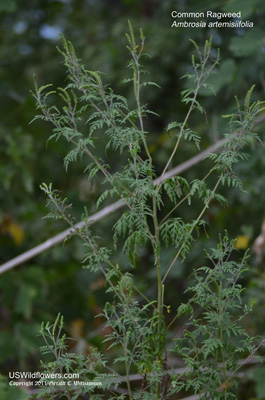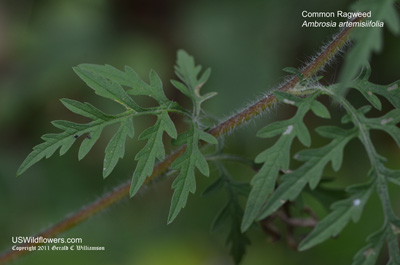Wildflowers of the United States | |||||||||||||
| |||||||||||||
Ambrosia artemisiifolia - Common Ragweed, Annual Ragweed, Small Ragweed, Roman Wormwood. The leaves and stem of Common Ragweed are hairy. The leaves are deeply lobed and quite ragged. The inflorescence is a slender, almost candle-like cluster at the end of the stems. The upper flowers are usually male; the lower flowers female. | The ragweeds generally cause much hayfever, allergic reaction, and asthma exacerbation due to their tiny airborne pollen, which can drift and be inhaled far from the source plant. Because of this, other plants which bloom at the same time, such as Goldenrod, frequently get blamed for ragweed-caused hayfever. Common ragweed is found in every state in the United States except for Alaska, and is found in most of Canada. While it is an introduced species in Hawaii, it is native to continental North America. Two varieties of the plant are native to the eastern United States; a variety found in the all but a few southeastern states is native to Canada but not to the United States, according to the USDA Plants Database. It is officially listed as a noxious weed in Illinois, Michigan, and Oregon, and is thus legally controlled. It is considered a weed due to agricultural considerations in much of the United States. Found in: AL, AR, AZ, CA, CO, CT, DC, DE, FL, GA, HI, IA, ID, IL, IN, KS, KY, LA, MA, MD, ME, MI, MN, MO, MS, MT, NC, ND, NE, NH, NJ, NM, NV, NY, OH, OK, OR, PA, RI, SC, SD, TN, TX, UT, VA, VT, WA, WI, WV, WY Leave comments on Ambrosia artemisiifolia at this link.   Blue=Native; Grey=Introduced Map from USDA Plants Database: USDA, NRCS. 2017. The PLANTS Database (http://plants.usda.gov, 08 May 2025). National Plant Data Team, Greensboro, NC 27401-4901 USA. Search Our Database: Enter any portion of the Scientific, Common Name, or both. Do a general Google search of the entire site: #ad
| #ad
| | ||||||||||
|
Commercial / Cookie Notice Looking for Wildflowers for a specific state? Check here: | |||||||||||||
|
| |||||||||||||



